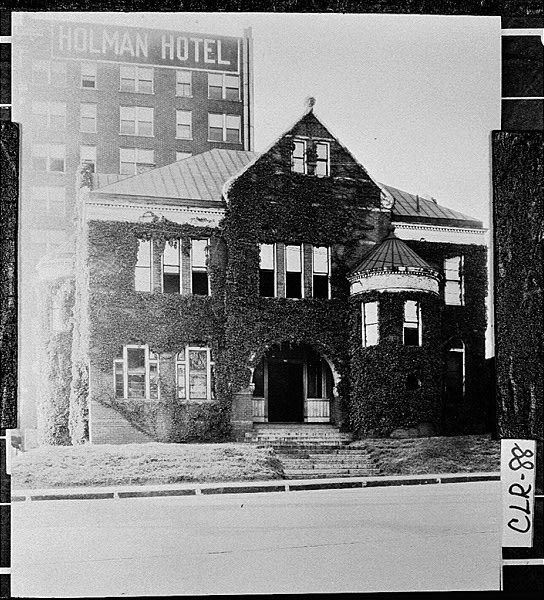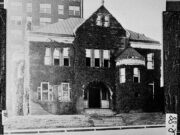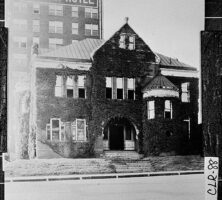The legal profession has always ranked among the most important forces in Georgia’s politics and economy.
Georgia lawyers have been U.S. Supreme Court justices and attorneys general. One Georgia attorney, Woodrow Wilson, became president of the United States. Lawyers prominent in the state’s history include George Walton, Joseph E. Brown, William Harris Crawford, Alexander Stephens, John B. Gordon, Thomas E. Watson, Carl Vinson, Walter George, Richard Russell Sr., Herman Talmadge, Griffin Bell, and the poet Sidney Lanier.
Special rights and duties define the legal profession. According to the 2004 Official Code of Georgia Annotated, only a certified attorney can “render legal services of any kind.” This includes “action taken for others in any matter connected with the law.” In exchange for this privilege, state law requires lawyers to maintain respect for courts and judges. They are to “abstain from offensive personalities,” avoid litigation based on personal interest, and never reject the cause of the defenseless or oppressed “for a consideration personal to themselves.”
In early 2003 approximately 27,000 lawyers were active in Georgia. Admission to the bar has become more difficult in recent decades as a result of higher education and testing standards. The State Bar of Georgia regulates the profession by controlling lawyer discipline. Since the 1960s the bar has experienced exponential growth, especially in urban areas, as well as dramatically higher racial and gender diversity. The legal profession is increasingly linked to large corporate and government institutions, and lawyers’ incomes are above the state average.
Admission to the Profession
The qualifications to become an attorney have changed radically over time. In 1789 the Georgia General Assembly decided that an oral examination by a superior court judge and evidence of “moral rectitude” were sufficient barriers. Georgia’s lax approach contributed to a rising population of lawyers, who numbered 1,168 in 1860. During the Civil War (1861-65) the General Assembly imposed new restrictions. Applicants had to possess state citizenship and good moral character. They were required to have “read law” for some unspecified time and to pass an oral examination in superior court that covered English law in force in Georgia, pleading and evidence, equity, the codes of the state and the Confederacy, and local practice rules. The law limited membership to the “white male citizen.” Similar requirements persisted for most of the nineteenth century. The number of lawyers reported by the 1900 census amounted to 2,385, reflecting a growth rate between 1860 and 1900 that was lower than that of the general population.
The Georgia Bar Association, an organization of attorneys formed in 1883, pressed for higher admission standards. The association’s efforts produced laws in the 1890s that required a written examination. Yet the General Assembly undercut the examination’s potential impact. Diploma privileges, which allowed graduates of a law school authorized by the state to be admitted without examination, were not abolished until 1933. Despite the diploma privileges, between 1900 and 1940 the number of lawyers increased only by about 10 percent, to 2,620, while the state’s population grew by more than 40 percent.
Fundamental changes in admission rules occurred after 1945. The General Assembly gave the Supreme Court of Georgia broad powers. The Office of Bar Admissions and a six-member Board of Bar Examiners were charged with overseeing the process. By 2003 the Supreme Court generally required that candidates earn a bachelor’s degree and a law degree from a law school accredited by the American Bar Association (ABA) before taking and passing a written examination. The two-day test evaluates knowledge on more than a dozen legal topics, including torts, contracts, real property, civil procedure, and criminal law. Applicants are also required to demonstrate that they have “the integrity and character requisite to be members of the Bar of Georgia.”
Legal Education
Transformations in legal education accompanied shifting admission standards. In the eighteenth and nineteenth centuries formal education was not needed. Young men usually learned about law by serving apprenticeships in law offices or by studying outside the state. An exception was the Lumpkin Law School in Athens, which was created in 1859 and closed in 1861 for the duration of the Civil War. In 1867 the school reopened as the department of law at the University of Georgia. Mercer and Emory universities also established law schools in the nineteenth century. A tradition of legal education outside the college setting began, most notably with the Atlanta Law School. Several other independent schools survived into the late twentieth century.

Courtesy of Georgia Archives.
In 2005 Georgia’s five ABA-accredited law schools were located at Emory University, Georgia State University, John Marshall Law School, Mercer University, and the University of Georgia. Approximately 2,500 students currently attend these schools. About half are women, and roughly 16 percent belong to racial minorities. Admission is selective. In 2002 no law school in the state admitted as many as half of its applicants. Courses offered are similar, largely because of the ABA’s expectations and the uniformity of subjects on American bar examinations. No school emphasizes Georgia law, and faculties are drawn from a national pool. Programs leading to the Juris Doctor (J.D.) degree normally take three years to complete. A high percentage of graduates, typically greater than 85 percent, passes the state bar examination on the first effort.
The State Bar of Georgia
In 1963 the General Assembly required all bar members to join the newly formed State Bar of Georgia. The legislation creating the state bar organization, which went into effect in 1964, arose from the principle that attorneys are officers of the state’s courts. As a result, the perceived public functions of lawyers led to additional regulation.
Currently the State Bar maintains a battery of programs. It performs lobbying activities in the General Assembly and monitors the unauthorized practice of law. It sponsors publications and regular meetings and maintains committees on areas of interest to attorneys. Most important, it has adopted and enforced a code of ethics and discipline. The bar’s Office of General Counsel possesses broad power to investigate violations of the ethics code and seek sanctions, including disbarment, against offending attorneys.
Population and Social Characteristics
Ironically, the number of Georgia lawyers grew most rapidly when qualifications for admission became most stringent. The State Bar counted approximately 3,400 lawyers in 1963. By 1970 the number of active lawyers had risen to about 5,100. In 1985 the bar had about 14,000 members. This represented a growth of more than 400 percent in twenty years. The increase continued through the 1990s, but at a slower rate. In 1990 there were 17,958 Georgia lawyers, while in early 2003 the bar reported 26,936 active members.
Attorneys are not equally distributed. More than two-thirds—almost 18,000—reside within sixty miles of Atlanta. Forty percent work in one county, Fulton. Adding the roughly 2,000 lawyers located in Bibb (Macon), Chatham (Savannah), Muscogee (Columbus), and Richmond (Augusta) counties to the Atlanta total yields almost 75 percent of the state’s attorneys practicing in the five largest urban centers. In contrast, 18 of Georgia’s 159 counties have only one or two lawyers, and five rural counties have no resident attorneys. Differences between Atlanta-area lawyers and the remainder of the bar have generated tensions within the profession.
The bar possessed distinctive racial characteristics until the 1970s. Although Black men began to be admitted after the Civil War, the number of African American attorneys in Georgia remained small through the 1960s. No Black woman was admitted until 1943. The 1890 census reported 17 Black male lawyers, a figure that decreased to 8 by 1940 and rose to just 54 in 1970. After 1970 the number of African American attorneys grew dramatically, reaching more than 1,100 in 1990. The State Bar does not maintain records on members’ racial identities, but it is likely that the number of Black attorneys in 2000 was greater than 1,600, or about 6 percent of bar membership. The census estimated approximately 150 Hispanic and 50 Asian American lawyers in 1990, numbers that undoubtedly increased in the years that followed.
Women have been eligible for bar membership since 1916, yet they did not become a significant portion of the profession until after 1970. In 1940 the census counted 60 women lawyers. Thirty years later the figure increased to 245, or about 5.6 percent of all attorneys. Since then there has been rapid growth. Therewere 1,426 in 1980, 3,739 in 1990, and 7,933 in 2003, when women represented almost 30 percent of Georgia lawyers. In the July 2002 bar examination, more than 50 percent of the successful applicants were women. In 2003 women and male members of racial minorities constituted more than one-third of all attorneys practicing in Georgia.
Economic Characteristics
The evolving structure of the bar has reflected trends in Georgia’s economy. Lawyers have consistently had earnings far above state norms. In 1960 the census estimated the median income of employed lawyers at $9,300, which increased (in current dollars) to $28,800 in 1980. In November 2003 the Bureau of Labor Statistics put the mean annual income for employed attorneys at $101,870, among the highest of any Georgia occupation. Lawyers in Georgia earn money as salaried employees and through hourly fees, contingency fees (in which payment depends on success),and fees based on specific tasks. A 2001 survey of Atlanta attorneys found that their average hourly rate—a form of billing common for business clients—was $265 per hour. Hourly rates for lawyers outside Atlanta tended to be lower.
The work of Georgia lawyers has become more specialized. General practitioners, who perform civil, criminal, office, and courtroom work, are increasingly rare. On the other hand, expanding state and federal governments employ attorneys as prosecutors and in state and local administrative agencies. In May 2003 Governor Sonny Perdue signed the Georgia Indigent Defense Act, which created the Georgia Public Defender Standards Council and circuit-wide public defender offices in the state.
The movement toward institutional work is reflected in the state’s many corporate legal departments. Some of the largest businesses, such as AT&T, have hired dozens of full-time lawyers. Business needs also produced private law firms with national and international practices. In 2002 nine Georgia firms employed more than 150 attorneys. The largest, King and Spalding, employed 786 lawyers in 2004. King and Spalding’s revenue in 2003 exceeded $425 million. Another important branch of the bar represents persons making claims against businesses for personal and property injuries.





